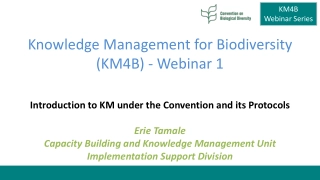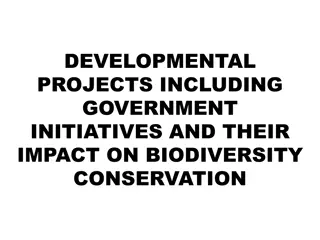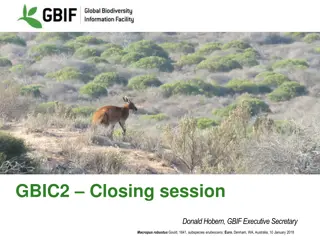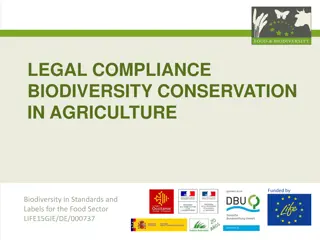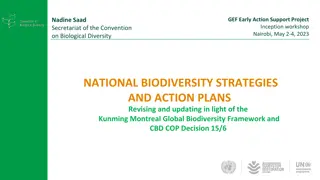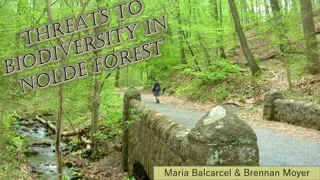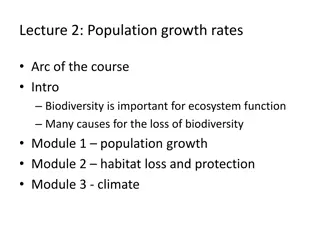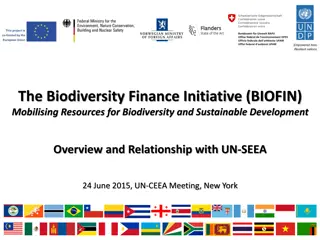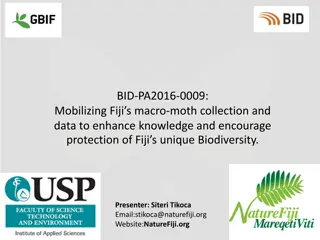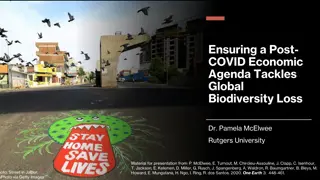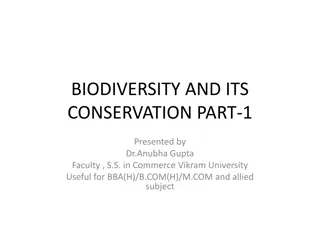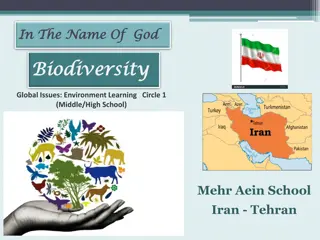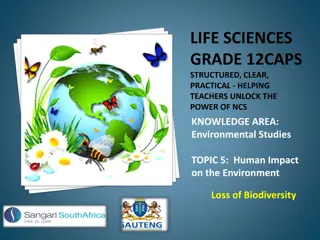Understanding Biodiversity and Conservation: Importance and Key Concepts
Biodiversity is the variety of life on Earth, encompassing all species and ecosystems. Conservation efforts are crucial to preserve genetic, species, and ecological diversity. The values of biodiversity range from productive and economic to social and aesthetic. Maintaining a balance in ecosystems, providing biological resources, and supporting social benefits are essential elements. Losses in biodiversity are caused by habitat destruction, overexploitation, pollution, climate change, deforestation, and introducing new species. Key stone, indicator, and umbrella species play vital roles in ecosystem health and stability.
Download Presentation

Please find below an Image/Link to download the presentation.
The content on the website is provided AS IS for your information and personal use only. It may not be sold, licensed, or shared on other websites without obtaining consent from the author. Download presentation by click this link. If you encounter any issues during the download, it is possible that the publisher has removed the file from their server.
E N D
Presentation Transcript
BIODIVERSITY AND CONSERVATION
The variety of life on earth that includes all species of plants ,animals, other organisms and the ecosystems within which they live and interact and also the totality of genes found in the organisms is known as biodiversity. The term biodiversity coined by W.G. Rosen in 1985 LEVEL OF BIODIVERSITY: Genetic diversity: The diversity of the organisms as a result of gene content is known as genetic diversity. 2. Species diversity: The diversity of the organisms at species level is known as species diversity. 3. Ecological diversity: Diversity of organisms as a result of different types ecosystem is known as ecological diversity. BIODIVERSITY 1. AND CONSERVATION
1. TYPES OF ECOLOGICAL DIVERSITY Alpha Diversity: Diversity of organisms found in a small localized area is known as alpha diversity. 2. Beta diversity: The species found in different habitats within the same geographical region is known as beta diversity. 3. Gamma diversity: The diversity of organisms found in different regions of a large geographical area. BIODIVERSITY AND CONSERVATION
VALUES OF BIODIVERSITY 1. Productive value 2. Consumptive value 3. Social value. 4. Aesthetic value 5. Legal value. 6. Ecological value 7. Economic value. BIODIVERSITY AND CONSERVATION
IMPORTANCE OF BIODIVERSITY 1. Maintaining balance of the ecosystem: 2. Provision of biological Resources 3. Social benefit 4. Biodiversity and food. 5. Biodiversity and human health 6. Biodiversity and industry 7. Biodiversity and culture.
BIODIVERSITY AND CONSERVATION CAUSES OF LOSS OF BIODIVERSITY: 1. Habitat destruction 2. Over exploitation 3. Pollution 4. Climate change 5. Deforestation 6. Introduction of new species
BIODIVERSITY AND CONSERVATION Key stone species: The species that form the central supportive hub in the ecosystem, the loss of which results in a collapse in ecosystem function as well as loss of coexisting species. Eg: Tiger, African elephant, flying fox. Indicator species: The species whose presence or absence or relative well being in a given environment is indicative of the health of ecosystem. Eg: lichen is the indicator species of air pollution Umbrella species: The species which are typically large, require lot of habitat, protecting large no area and other species. Eg; The cheetah can be considered as umbrella species.
BIODIVERSITY CONSERVATION Definition- The mechanism by means of which protection, preservation, management or restoration of genotype, species and ecosystem diversity is maintained is known as biodiversity conservation. METHOD OF BIODIVERSITY CONSERVATION Insitu Conservation: The method of conservation of biodiversity in the natural habitat of the organism is known as insitu conservation. Eg By forming National park, Biosphere Reserve, Wildlife sanctuary Exsitu Conservation: The method of conservation of biodiversity outside their natural habit in the man made system. Eg : By forming zoological garden , Botanical garden, Sperm bank , ovum bank, seed bank.
BIODIVERSITY CONSERVATION INSITU CONSERVATION METHOD NATIONAL PARK: The area of scenic beauty of historical importance owned by government where animals are kept and the environment is protected from human interference and is meant for recreational purposes. Example 1.Bandhabgarh National Park--Madhyapradesh 2.Gorumara National Park West Bengal 3. Jaldapara and Sundarban National park West Bengal 4. Simplipal National park Orissa 5. Corbett National park Uttarakhand 6. Gir National park Gujarat 7. Kanha National park Madhyapradesh
BIODIVERSITY CONSERVATION BIOSPHERE RESERVE: A Biosphere Reserve is a voluntary, cooperative, conservation reserve created to protect the biological and cultural diversity of a region while promoting sustainable economic development. Examples: 1. Great Rann of Katch Gujarat Indian wild Ass 2. Gulf of Manner Tamil Nadu Dugong 3. Sunarban West Bengal Royal Bengal Tiger 5. Cold Desert Himachal Pradesh Snow leopard 6. Nilgiri TamilNadu, Kerala, Karnataka Lion Tailed Macaque 7. Manas Assam Golden langur, Red Panda
BIODIVERSITY CONSERVATION WILD LIFE SANCTUARY An area kept in natural condition where it is illegal to interfere in anyway with natural life there and where killing and capturing of any animal is prohibited is known as wildlife Sanctuary. Example: 1.Buxa and Gorumara, Chapramari West Bengal 2. Gumti Wildlife Sanctuary Tripura 3. Chilika Bird Sanctuary Orissa 4. Dalma Jharkhand 5. Dandeli Orissa
BIODIVERSITY HOTSPOT The geographic areas that contain high level of species diversity but are threatened with extinction are known as biodiversity hotspot. Examples 1. Western Ghats 2. Eastern Himalayas 3. Indo Burma
ENDANGERED SPECIES The native species whose number is declining due to threats and that faces a significant risk of extinction in the near future . Examples of few endangered plant species: 1. Rauvolfia serpentina 2.Nepenthes Examples of animal species : 1.Panthera tigris 2. Rhinoceros unicornis 3. Varanus monitor BIODIVERSITY CONSERVATION
BIODIVERSITY AND CONSERVATION RARE SPECIES: These are the animals of small population, geographically restricted at a localized habitat or may be scattered widely. Eg: Asian Golden Cat, Brown Bear, Common frog, giraffe, rock pigeon etc. VULNERABLE SPECIES: These species whose number is declining in the habitat and not being recovered because of over exploitation, extensive destruction of habitat or other environmental disturbance. Eg Cheetah, Dugong, Galapagos tortoise, Gaur, Mountain Zebra, polar bear, red panda, Sloth bear, yak.
EXTINCT SPECIES: These are the species which cannot be found in their natural habitat or other likely habitat. Eg Dodo bird, Golden toad, Japanese sea lion, woolly mammoth, Javan tiger. RED DATA BOOK : Red data book is the name given to a book which deals with the threatened plants and animals of any region of the world. This book is published by IUCN ( International Union for conservation of Nature and Natural Resources.) GREEN DATA BOOK: All these useful trees in recent years have attention of several ecologist and environmentalist and records of such data have been incorporated in Green data book. BIODIVERSITY AND CONSERVATION


